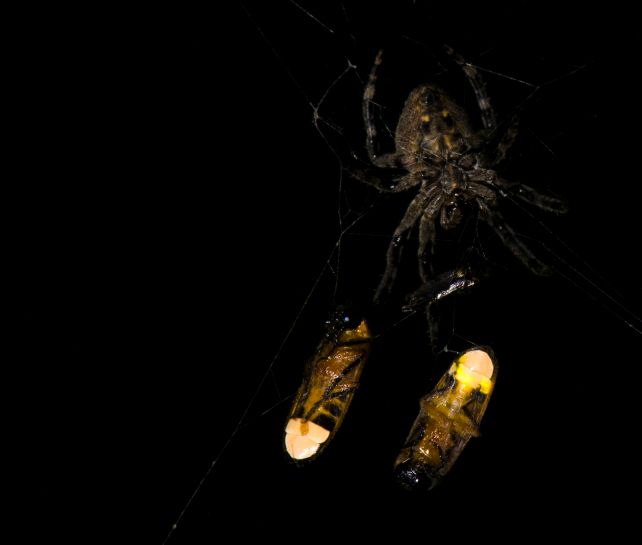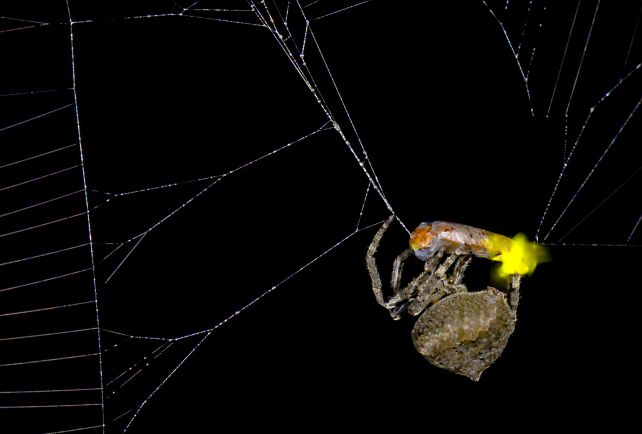An unassuming orb-weaving spider common across China, Japan, and Korea seems to have the powers of a master manipulator.
Araneus ventricosus has been observed catching male fireflies and inducing them to flash signal patterns usually used by females.
The result? More male fireflies, lured to the spider's web, by way of a gruesome honeypot.
It's not entirely clear how the spiders are triggering the female-like flashing patterns in male Abscondita terminalis fireflies, but new research implicates a clear cause-and-effect.
"Drawing from extensive field observations, we propose that Araneus ventricosus practices deceptive interspecific communication by first ensnaring firefly males in its web and then predisposing the entrapped male fireflies to broadcast bioluminescent signals that deviate from female-attracting signals typically made by A. terminalis males and instead mimic the male-attracting signals typically made by females," writes a team led by entomologist Xinhua Fu of Huazhong Agricultural University in China.
"The outcome is that the entrapped male fireflies broadcast false signals that lure more male fireflies into the web."
Fu, who has been investigating the bioluminescent courtship signaling of fireflies in the wild, first spotted something odd about the spiders on one of his field expeditions.
Of the fireflies snared in the sticky webs, almost all of them were male.

Taken in isolation, this might not mean much. But on subsequent expeditions, he found the same thing. Rarely was a female firefly found caught in the web of A. ventricosus, presenting a pattern too stark to shrug off as mere chance.
The researchers spent many nights studying the spiders and found that the fireflies' behavior became even more curious.
When signaling each other for mating purposes, male and female fireflies do so in specific ways. Males use two lanterns in their abdomens to make multi-signal chains of pulses. The females, on the other hand, use a single lantern to make single-pulse signals. In this way, the insects can differentiate between male and female signals, and find each other in the dark.
When snared in a web, the males were commonly seen flashing a single-lantern, single-pulse signal that females use to attract mates. This could be a coincidence, though, so the researchers conducted a field experiment to find out what is going on.
They observed free-flying fireflies approaching webs which they'd categorized depending on the presence or absence of spiders or trapped fireflies. For each of the 161 webs observed, they also studied the catch rate – how many fireflies the web had caught.
The researchers found that although all ensnared males flashed signals more similar to a female firefly, the presence of the spider was significantly correlated with a higher catch rate. Male fireflies caught in a web without a spider present were less likely to lure other fireflies to their doom.

This is inconsistent with the hypothesis that the fireflies, once caught in the web, emit distress signals.
And there was something else. When a flashing firefly was caught in its web, the spider moved in and deployed a distinctive, repeated wrap-and-bite attack. This attack only took place when the flashing of the firefly was visible; when fireflies with blacked-out lanterns were placed in the web, the spider did not use the attack sequence.
Although it's unclear whether venom or the bite itself is responsible for the behavior change, the researchers believe something about the attack causes a neurotransmitter to alter the signal style inside the insect.
It would not be the first time spiders have been caught using puppets. Orb-weaving spiders of the genus Cyclosa build large decoys out of dead insects and debris in the shape of a spider in the center of a web. Their goal might be a bit different, though – deterring predators, rather than luring prey.
And puppeteering a living, wriggling, doomed insect to lure its fellows to their own deaths is an entirely different level of evil genius. We're probably very lucky that the venom of A. ventricosus is harmless to vertebrates.
The research has been published in Current Biology.
